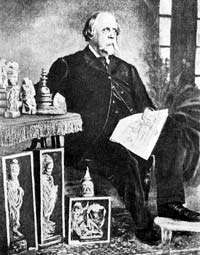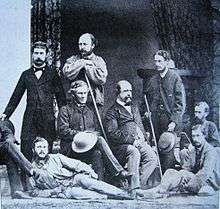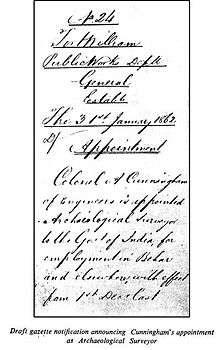Alexander Cunningham
| Alexander Cunningham | |
|---|---|
 | |
| Born |
23 January 1814 London |
| Died |
18 November 1893 (aged 79) London |
| Nationality | British |
Sir Alexander Cunningham KCIE CSI (23 January 1814 – 28 November 1893) was a British army engineer with the Bengal Engineer Group who later took an interest in the history and archaeology of India which led to his appointment in 1861 to the newly created position of archaeological surveyor to the government of India. He founded and organized what later became the Archaeological Survey of India. He wrote numerous books and monographs and made massive collections of artefacts. Some of his collections were lost but most of the gold and silver coins and a fine group of Buddhist sculptures and jewellery were bought by the British Museum in 1894.[1] Two of his brothers, Francis Cunningham and Joseph Cunningham became well known for their work in British India while another, Peter Cunningham, became famous for his Handbook of London (1849).[2]
Early life and career

Born in London to the Scottish poet Allan Cunningham (1784–1842) and his wife Jean née Walker (1791–1864). Along with his older brother Joseph Cunningham, he received his early education at Christ's Hospital, London. Allan and Alexander obtained cadetships through the influence of Sir Walter Scott and went to study at the East India Company's Addiscombe Seminary (1829–31), and at the Royal Engineers Estate at Chatham. He joined the Bengal Engineers at the age of 19 as a Second Lieutenant and spent the next 28 years in the service of British Government of India. Soon after arriving in India on 9 June 1833, he met James Prinsep. He was in daily communication with Prinsep during 1837 and 1838 and became his intimate friend, confidant and pupil.[3] Prinsep passed on to him his lifelong interest in Indian archaeology and antiquity. He was ADC to Lord Auckland, the Governor-General of India from 1836 to 1840. During this period he visited Kashmir, which was then not well explored. He finds mention by initials in Up the Country by Emily Eden. On 30 March 1840, he married Alicia Maria Whish, daughter of Martin Whish B.C.S.[4] He was appointed Colonel of the Royal Engineers in 1860. Cunningham retired in 1861, having attained the rank of Major General.[5][6]
Military life

Cunningham was made executive engineer to the king of Oudh in 1841. In 1842 he was called to serve the army in thwarting an uprising in Bundelkhand by the ruler of Jaipur. He was then posted at Nowgong in central India before he saw action at the Battle of Punniar in December 1843. He became engineer at Gwalior and was responsible for constructing an arched stone bridge over the Morar River in 1844-45. In 1845-46 he was called to serve in Punjab and helped construct two bridges of boats across the Beas river prior to the Battle of Sobraon. In 1846 he was made commissioner along with P. A. Vans Agnew to demarcate boundaries. Letters were written to the Chinese and Tibetan officials by Lord Hardinge, but no officials joined. A second commission was established in 1847 which was led by Cunningham to establish the Ladakh-Tibet boundary, which also included Henry Strachey and Thomas Thomson. Henry and his brother Richard Strachey had trespassed into Lake Mansarovar and Rakas Tal in 1846 and his brother Richard revisited in 1848 with botanist J.E. Winterbottom.[7][8] The commission was set up to delimit the northern boundaries of the Empire after the First Anglo-Sikh War concluded with the Treaty of Amritsar, which ceded Kashmir as war indemnity expenses to the British. [9] His early work Essay on the Aryan Order of Architecture (1848) arose from his visits to the temples in Kashmir and his travels in Ladakh during his tenure with the commission. He was also present at the battles of Chillianwala and Gujrat in 1848–9. In 1851, he explored the Buddhist monuments of Central India along with Lieutenant Maisey, and wrote an account of these.[10] He was appointed as the chief engineer of Burma in 1856 for two years, and later for three years from 1858 he served in the same post in the North-Western Provinces. In 1856, Cunningham was made chief engineer for Burma which had just been annexed. He established a public works department there and was entirely absent during the Indian Rebellion of 1857. In 1858 he was posted chief engineer to the North-Western Provinces, where he once again established a public works department. He retired on 30 June 1861 as a Major General.[5]
Archaeological Survey of India
Cunningham had taken a keen interest in antiquities early in his career. Following Jean-Baptiste Ventura, general of Ranjit Singh, who inspired by the French explorers in Egypt had excavated the bases of pillars to discover large stashes of Bactrian and Roman coins, excavations became a regular activity among British antiquarians.[11] In 1834 he wrote to the Journal of the Asiatic Society of Bengal, an appendix to James Prinsep's article on the relics in the Manikyala Tope. He had conducted excavations at Sarnath in 1837 along with Colonel F.C. Maisey and made careful drawings of the sculptures. In 1842 he excavated at Sankissa and at Sanchi in 1851. In 1848, he identified some of the places mentioned in the travels of Hwan Thsang.[12] In 1854 he published The Bhilsa Topes, an attempt to establish the history of Buddhism based on architectural evidence.
By 1851 he also began to communicate to William Henry Sykes and the East India Company on the value of an archaeological survey. He provided a rationale that could earn the funding needed for the venture stating that:[11]
...would be an undertaking of vast importance to the Indian Government politically, and to the British public religiously. To the first body it would show that India had generally been divided into numerous petty chiefships, which had invariably been the case upon every successful invasion; while, whenever she had been under one ruler, she had always repelled foreign conquest with determined resolution. To the other body it would show that Brahmanism, instead of being an unchanged and unchangeable religion which had subsisted for ages, was of comparatively modern origin, and had been constantly receiving additions and alterations; facts which prove that the establishment of the Christian religion in India must ultimately succeed.[13]

In 1861, Charles John Canning, then the viceroy of India appointed Cunningham as archaeological surveyor to the government of India.[14] This position was held from 1861 to 1865 but this was terminated due to lack of funds. Cunningham returned to England and wrote the first part of his Ancient Geography of India (1871) to cover the Buddhist period but failed to complete the second part to cover the Muslim period. During this period in London he worked as director of the Delhi and London Bank.[15] In 1870, Lord Mayo re-established the Archaeological Survey of India with Cunningham as its director-general from 1 January 1871. Cunningham returned to India and made field explorations each winter, conducting excavations and surveys from Taxila to Gaur. He produced twenty-four reports, thirteen as author and the rest under his supervision by others such as J. D. Beglar. Other major works included the first volume of Corpus inscriptionum Indicarum (1877) which included copies of the edicts of Asoka, the Stupa of Bharhut (1879) and the Book of Indian Eras (1883) which allowed dating of Indian antiquities. He retired from the Archaeological Survey on 30 September 1885 and returned to London to continue his research and writing.[5]
Cunningham made a large numismatic collection, but much of this was lost when the steamship he was travelling in, the Indus, was wrecked off the coast of Sri Lanka in November 1884. The British Museum however obtained most of the gold and silver coins. He had suggested to the British Museum that they should use the arch from the Sanchi Stupa to mark the entrance of a new section on Indian history. He also published numerous papers in the Journal of the Asiatic Society and the Numismatic Chronicle.[16]
Awards and memorials
He was awarded the CSI on 20 May 1870 and CIE in 1878. In 1887, he was made a Knight Commander of the Order of the Indian Empire.[4] Cunningham died on 28 November 1893 at his home in South Kensington and was buried at Kensal Green cemetery, London. His wife had died earlier and was survived by two sons, Lieutenant-Colonel Allan J. C. Cunningham (1842–1928) of the Bengal and Royal Engineers, and Sir Alexander F. D. Cunningham (1852–1935) of the Indian Civil Service.[5]
Publications
Books written by him include:
- LADĀK: Physical, Statistical, and Historical with Notices of the Surrounding Countries (1854).
- Bhilsa Topes (1854), a history of Buddhism
- The Ancient Geography of India (1871)
- Corpus Inscriptionum Indicarum. Volume 1. (1877)
- The Stupa of Bharhut: A Buddhist Monument Ornamented with Numerous Sculptures Illustrative of Buddhist Legend and History in the Third Century B.C. (1879)
- The Book of Indian Eras (1883)
- Coins of Ancient India (1891)
- Mahâbodhi, or the great Buddhist temple under the Bodhi tree at Buddha-Gaya (1892)
References
- ↑ British Museum Collection
- ↑ Cunningham, Joseph Davey (1849). Cunningham's History of the Sikhs. John Murray. pp. xii–xiv.
- ↑ Kejariwal, O.P. The Asiatic Society of Bengal and the Discovery of India's Past 1784-1838 (1988 ed.). Oxford University Press. p. 200. ISBN 0 19565089 1.
- 1 2 Cunningham, A. (1871). The Ancient Geography of India, Vol. 1. India: Trübner and Co.
- 1 2 3 4 Cotton, J. S. & James Lunt (reviser) (2004). "Cunningham, Sir Alexander (1814–1893)". Oxford Dictionary of National Biography. Oxford University Press. doi:10.1093/ref:odnb/6916.
- ↑ Vibart, H.M. (1894). Addiscombe: its heroes and men of note. Westminster: Archibald Constable. pp. 455–9.
- ↑ Waller, Derek J. (2004). The Pundits: British Exploration of Tibet and Central Asia. University Press of Kentucky. p. 13.
- ↑ Strachey, Henry (1854). Physical geography of Western Tibet. London: William Clowes and sons. pp. iii.
- ↑ Cunningham, A. (1854). Ladak, physical, statistical and historical. London: W.H.Allen and co.
- ↑ Cunningham, A. (1854) The Bhilsa Topes, or Buddhist Monuments of Central India. London
- 1 2 "Sir Alexander Cunningham (1814-1893): The First Phase of Indian Archaeology". Journal of the Royal Asiatic Society of Great Britain and Ireland (3–4): 194–207. 1963.
- ↑ Cunningham, Alexander (1848). "Verification of the Itinerary of the Chinese Pilgrim, Hwan Thsang, through Afghanistan and India during the First Half of the Seventh Century of the Christian Era". Journal of the Royal Asiatic Society of Bengal. 17 (2): 13–60.
- ↑ Cunningham, A (1843). "An Account of the discovery of the Ruins of the Buddhist City of Samkassa". Journal of the Royal Asiatic Society: 241–247.
- ↑ Cunningham, Alexander (1871). Archaelogical Survey of India. Four reports made during the years 1862-83-64-65. Simla: Government Central Press. pp. i–iii.
- ↑ Iman, Abu (1966). Sir Alexander Cunningham and the beginnings of Indian archaeology. Dacca: Asiatic Society of Pakistan. p. 191.
- ↑ Mathur, Saloni (2007). India by Design: Colonial History and Cultural Display. University of California Press. p. 146.
| Wikimedia Commons has media related to Alexander Cunningham. |